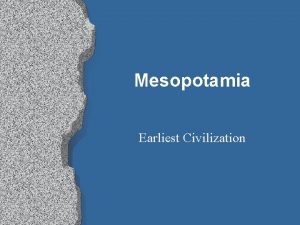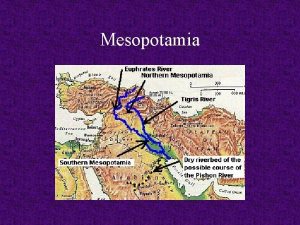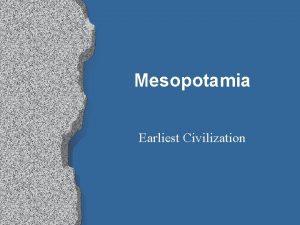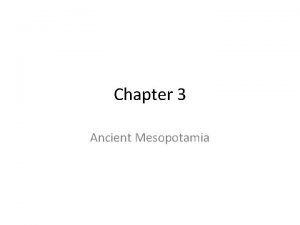Mesopotamia Grows From citystates to Empire First EMPIRE













- Slides: 13

Mesopotamia Grows From city-states to Empire

First EMPIRE Builders – The Akkadians • • 3, 000 – 2, 000 B. C. E. the Sumerian city-states began to war with each other, making them too weak to ward off an attack by an outside enemy. Sargon of Akkad (c. 2, 300 B. C. E. ) – Sargon took control of the region, creating world’s first empire - when several peoples, nations, or previously independent states are placed under the control of one ruler. – The Akkadian Empire lasted about 200 years • Invasions, internal fighting and famine led to the downfall of the empire. – Spoke a Semitic language (related to Arabic & Hebrew). sample Akkadian text Arabic Hebrew

The Mesopotamian Empires After the Akkadians, Mesopotamia had two main empires: Babylonia and Assyria. • The Babylonian empire lasted from around 1800 BC to 1600 BC. • The Assyrian empire lasted from around 665 BC to 612 BC.

Babylonian Empire • • Overtook Sumerians around 2, 000 B. C. and built the capital, Babylon, on the Euphrates river. Hammurabi (ruled from 1792 -1750 B. C. E. ) and was Babylon’s most famous king. – Famous Code of Law = Hammurabi’s Code • He wisely took all the laws of the region’s citystates and unified them into one code. This helped unify the region. • Engraved in stone, these were placed all over the empire. Why do you think he believed it important to place the laws in prominent locations so the people could visibly see them?

Hammurabi’s Code • Strict in nature – “the punishment fits the crime” = “eye for an eye” • Punishments were not equal across the social classes • Such laws were adopted by neighboring cultures • His act set an important precedent – idea that the government was responsible for what occurred in society. On the left is a stela, which has all 282 of Hammurabi’s laws engraved on it. This amazing find was discovered in 1901 and is located in the Louvre Museum in Paris, France.

Babylonian Math & Numbers

BABYLONIAN ZIGGURAT

Babylonia is Conquered • Hammurabi conquered many of the neighboring cities, and he kept expanding his empire. • Hammurabi would often go to war against his allies as well. When the city of Elam attacked Larsa, Hammurabi helped Larsa defend themselves. Once Elam was conquered, Hammurabi turned right around and conquered Larsa! • Each time that Babylon would conquer another city, Hammurabi would take the city’s chariots, weapons, tools, and all their riches. Trading helped Babylon get rich, but so did conquest. • Though Hammurabi formed a large and rich empire, the people that ruled after him could not keep it together. The empire kept getting smaller and smaller until eventually it was destroyed.

The Assyrians Rise to Power • Assyria was a small kingdom of walled cities that was located north of Babylon. Their city was located in open land that was easily attacked, and they had to constantly defend themselves against invaders. Therefore, they became skilled warriors. • At around 1365 B. C. E. , the Assyrians decided that the best defense they had was to attack other countries first, before they could attack them. By 650 B. C. E. , Assyria had conquered a large empire. • The Assyrians were geniuses at waging war. They invented the battering ram, which they used to pound down city walls. They used catapults to throw rocks at enemies, and the protected their archers with helmets and armor.

Assyrian Learning • The capital of the Assyrian Empire was a city called Nineveh became a great city of learning. It had a famous library that held thousands of clay tablets with writings from Sumer and Babylon. These records tell us a lot about life in Mesopotamia.

Assyria Overthrown • The people that the Assyrians conquered were constantly rebelling against Assyrian rule. Most of the time, the Assyrians crushed the people who tried to fight them. However, in 612 B. C. E. , two groups joined together to smash the Assyrian empire. These groups were the Medes and the Chaldeans.

The New Babylonian Empire • The Chaldeans created a new empire, centered at Babylon after they defeated the Assyrians in 612 B. C. E. The greatest king of New Babylon was Nebuchadnezzar II. He rebuilt Babylon and put massive walls around the city to protect it. He also built a great palace with hanging gardens. • Under the Chaldeans, the New Babylonian Empire became a center of learning and science. Chaldean astronomers charted stars and measured the correct length of the year. Chaldean farmers raised bees for their honey. Many people came to Babylon to share ideas and discoveries.

The Fall of the 2 nd Babylonian Empire • The second Babylonian empire came under attack and was defeated by the Persians, who were led by Cyrus, in 539 B. C. E. Though the Chaldeans were defeated, the city of Babylon was spared from destruction. • The innovative ideas of the Sumerians and their descendants in the region would be adopted by the later peoples – including the Persians, Phoenicians and the Hebrews. We’ll discuss these people later.
 Socratic problem
Socratic problem Agora
Agora American empire vs british empire
American empire vs british empire Byzantine empire vs roman empire venn diagram
Byzantine empire vs roman empire venn diagram Venn diagram of mauryan and gupta empires
Venn diagram of mauryan and gupta empires Where the red fern grows vocabulary
Where the red fern grows vocabulary Where the red fern grows chapter 12 summary
Where the red fern grows chapter 12 summary Where the red fern grows comprehension questions
Where the red fern grows comprehension questions Where the red fern grows comprehension questions
Where the red fern grows comprehension questions Redbone coonhound where the red fern grows
Redbone coonhound where the red fern grows Stack and stack pointer
Stack and stack pointer Love versus in love
Love versus in love Betty beaumont land art
Betty beaumont land art Stack grows downwards
Stack grows downwards
























